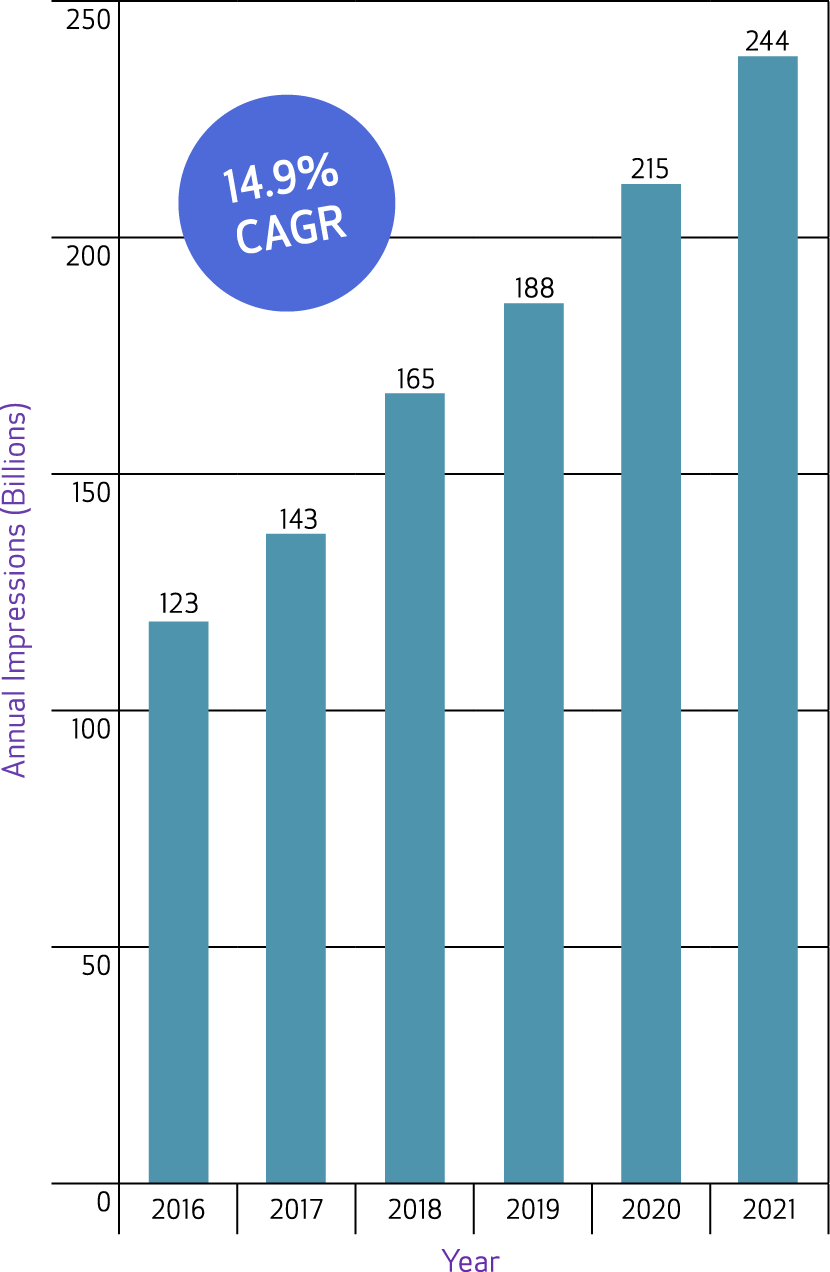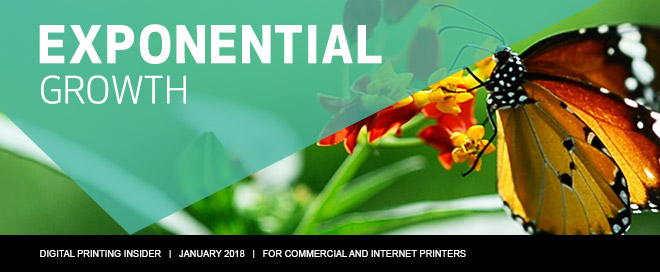5 Tips on How Service Providers Can Achieve Sustained Growth
HIGH-SPEED INKJET: A VIABLE OPTION IN 2018
Today’s high-speed inkjet printing devices are a viable option for print service providers that are willing to make the investment. The technology is maturing and is no longer a test market for larger companies that are seeking to gain a competitive advantage. As we enter a new year of technological advancements, applications printed on production inkjet devices will continue to evolve and expand. The quality and productivity of high-speed inkjet devices has increased over the past few years, and this is transitioning work that was previously produced using offset and toner processes to inkjet devices. Inkjet technology offers high-volume applications the advantages of digital print production, including electronic collations, just-in-time manufacturing, and workflow automation, while also providing very high speeds that were once only available from offset.
Figure 1: U.S. Annual Inkjet Impressions: 2016-2021

Source: U.S. Production Printing and Copying Market Forecast: 2016-2021; InfoTrends 2017
The commercialization and implementation of inkjet printing is enabling the production of affordable full-color work and personalization with faster turnaround times. Moving forward, ongoing innovations in inkjet will drive substantial growth in digital page volumes. InfoTrends estimates that inkjet devices produced more than 122 billion impressions in the United States in 2016, and that number is predicted to reach 246 billion impressions by 2021?—?a 14.9% CAGR (Compound Annual Growth Rate). (See Figure 1)
This growth is occurring despite the fact that sheet-fed electrophotographic digital printing is also growing at a healthy rate. The dramatic growth that inkjet is enjoying is the result of sheet-fed inkjet developments, continued innovations in roll-fed technology, new applications, a drive for more customized communications, and the cost-effective migration of offset volume to digital based on significant improvements in speed, substrates, quality, and cost.
In its most recent U.S. Application Forecast, Keypoint Intelligence — InfoTrends shares the largest applications by page volume in 2016 and their growth through 2021. All of the top applications account for more than 10 billion impressions in 2016. By 2021, the top three applications will be books, direct mail, and bills/statements. Their combined volumes are expected to reach about 286 billion impressions, or 41% of the total volume.
Print service providers that focus on these top applications are committed to faster turnaround times, reduced costs, and quality manufacturing. Over the past decade, these applications have been migrating past the gap from offset to digital, specifically high-speed inkjet technologies. Other applications such as promotional print, calendars, maps, diaries, manuals, and newsletters are all growing from the increasing benefits of color inkjet and the various substrates that are available today.
While personalization has historically been a benefit of digitally printed direct mail, brochures, flyers, and leaflets are also becoming more targeted and customized. The increasing quality of digital color devices has dramatically fueled the acceptance of digital printing over the past few years. Output from many ultra-high-volume color inkjet printers is improving and paper choices are expanding rapidly, generating predictions for even stronger growth in the year ahead.
FACTORS TO CONSIDER WHEN PLANNING INVESTMENT STRATEGIES:
1
REVIEW APPLICATION MIX
2
INVEST IN AND BUILD DATA SKILLS
3
JUSTIFY THE INVESTMENT
4
AUTOMATE WORKFLOW PROCESSES
5
INVEST IN EDUCATION
Innovations in high-speed inkjet systems have enabled the creation of products that print at higher speeds, wider web widths, and quality levels that are comparable to offset. Successful early adopters have put a stake in the ground for inkjet’s value proposition. Along with very compelling cost-per-page metrics, high-speed continuous feed inkjet systems enable true business model transformation related to customer operations, targeting and personalization, and profitability.
Although production inkjet is certainly a fast-growing segment of the market, merely investing in a press is not enough to drive business results. To build a print business that delivers sustained growth, service providers must develop a smart and strategic plan. There are several key factors that should be part of your overall investment strategy. As you map out your 2018 investments and strategies for inkjet growth in the new year, consider the following tips:
- Review your application mix. Since production inkjet is application driven, it’s important to consider how inkjet can help you build value for your customers. When reviewing your application mix, you must also understand how to streamline production and lower costs with high-speed inkjet system integration.
- Invest and build your data skills. The real value of inkjet comes from doing things that can’t be done with other print technologies, like producing more affordable high-value personalization, shorter runs, and versioning. To capitalize on this opportunity, print service providers must build their data skills.
- Justify the investment. The most successful inkjet users are carefully analyzing the business opportunity and identifying parts of their business with ample volume to justify the investment before purchasing inkjet equipment.
- Automate workflow. Workflow processes are at the heart of successful production inkjet implementation. By taking as many steps out of the process and eliminating as many manual touches as possible, service providers can become more cost-efficient, improve margins, shorten production time, and deliver added value.
- Invest in education. The way that you market a new inkjet solution to your customers will influence its acceptance. There are a variety of options for selling the value that inkjet delivers, but the key is ensuring that the right message is communicated through the right medium to the right audience.
Although implementation is not without its challenges, inkjet is beginning to take hold in the traditional commercial print market. High-speed inkjet isn’t just for early adopters?—?2018 is a great time for all commercial printers who are looking to drive business growth to develop a strategic roadmap for implementing inkjet. In the coming months, Canon will share more insights on the high-speed inkjet market from InfoTrends’ publication entitled “High-Speed Inkjet Printing in Commercial Print Markets,” which will be released in the spring of 2018.
